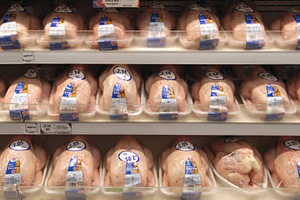EU projects further growth in poultry meat

Poultry meat is the only meat for which production and consumption in the European Union are expected to expand significantly over the next ten years, according to the European Commission in its report Prospects for EU agricultural markets and income 2014-2024.
Both production and consumption will grow by 7% in 2024 as compared with 2014. The outbreak of avian flu in November 2014 on farms in Germany, the Netherlands and the United Kingdom (Yorkshire) is not expected to have a significant impact on overall production in 2014, forecast at around 13 million tonnes, as corrective and preventive measures were immediately put in place, the EC says.
EU meat production is expected to increase to 44.9 million tonnes, which is driven mainly by sustained expansion in poultry meat, the report says. While total meat consumption is trending downwards, poultry meat is the only sector for which the EC projects an increase.
In recent years, production of poultry meat has served to fill the gap left by reduced supply of beef and pig meat. At the same time, EU meat exports could rise further because of bigger populations and strong economic growth in developing countries (albeit slower than in the previous decade) which support higher world meat demand. Supported by that sustained global demand, the EU will maintain its market share with EU exports accounting for 10% of global trade.
Poultry meat is enjoying several comparative advantages over other meats, including price affordability, convenience, healthier image, limited greenhouse gas emissions, lower production costs, shorter rearing time and lower levels of investment required, the EC says. One of the other advantages the report mentions is the absence of any religious guidelines limiting consumption. “As a result, production and consumption have been steadily increasing for many years now.” This increase was mainly concentrated in a number of member states that are major producers — Germany, Spain, the Netherlands and Poland which together accounted for 44% of total EU production in 2013.
On the trade side, after an exceptional export performance in 2012, and despite the complete removal of export refunds in 2013, mainly affecting those supplying Saudi-Arabia, EU shipments are expected to fall by only around 1% in 2014. The Russian import ban is not having a major effect on the poultry market, as Russian demand was already slowing. The EU market will probably be able to divert the surplus to other destinations, mainly to countries in the Middle East and Africa, especially South Africa.
Imports into the EU also declined over two consecutive years (2013 and 2014). Political tensions in Thailand and the country’s reorientation to geographically closer markets resulted in lower exports to the EU, while Brazil, benefiting from the Russian ban imposed on the EU and from falling EU exports to Saudi Arabia, increasingly supplied these two markets at the expense of the EU.
The production of poultry meat is expected to continue to grow steadily over the outlook period, but the rate of growth is very likely to slow to 0.7% per year, having averaged 1.7% over the past ten years. The strongest increase in production (at 1% per year) is expected to be seen in the so-called newer member states, due largely to sustained productivity gains in Hungary, Poland and Romania. The other highest-producing countries are EU-15 Member States (e.g. Germany and the Netherlands), where production is expected to grow by 0.5% per year. With feed prices remaining lower than in recent years throughout the outlook period, strong domestic and world demand will together contribute to the increase in production, with total EU production expected to reach almost 14 million tonnes by 2024.













